
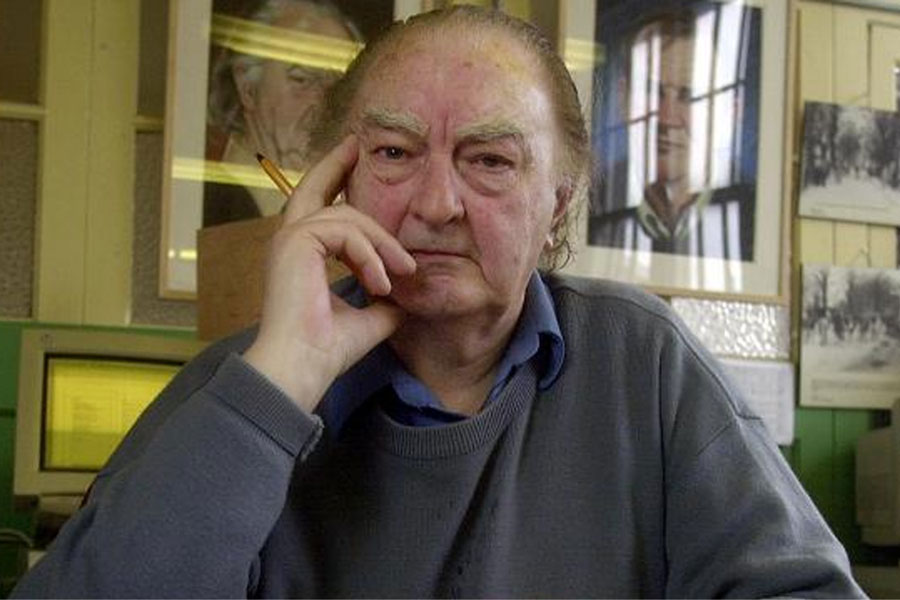
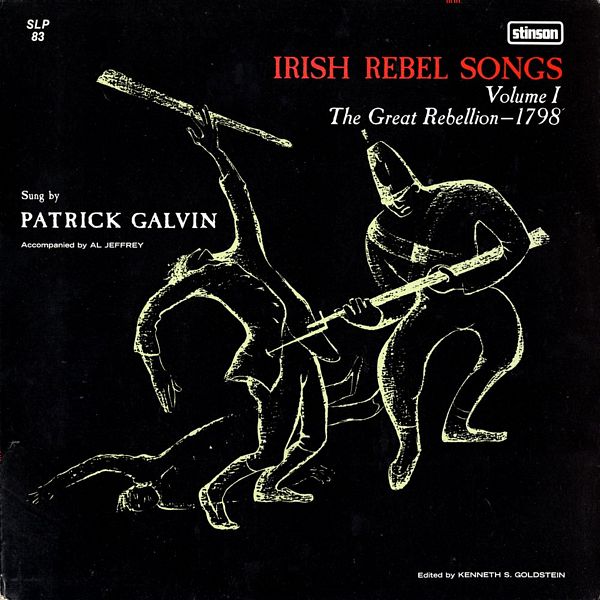 |
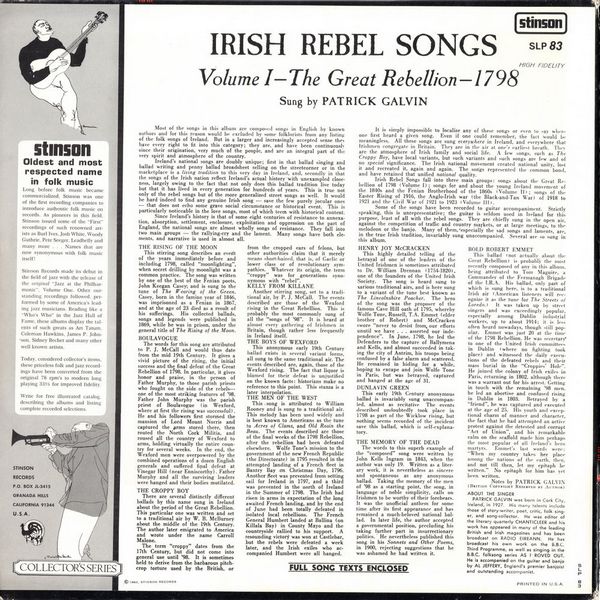
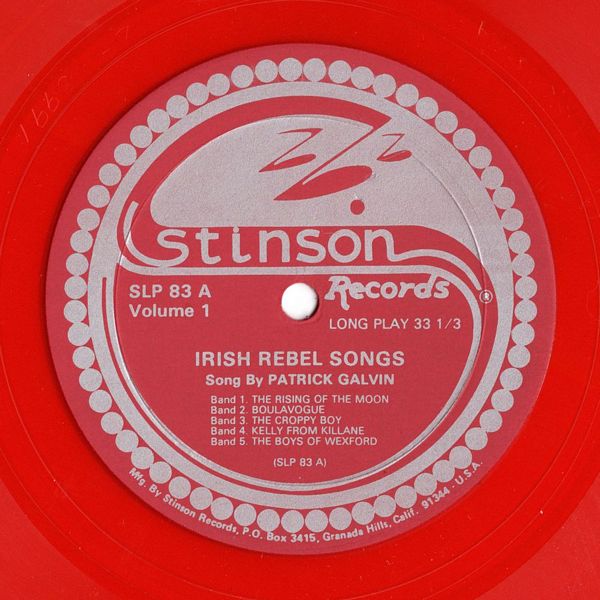
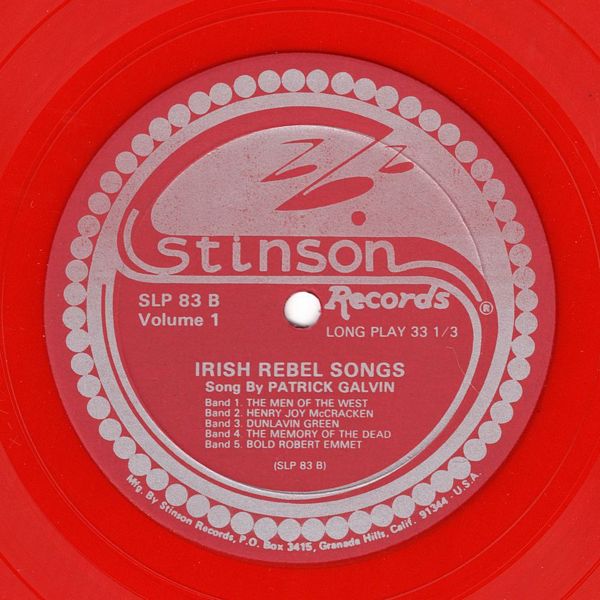 |
Sleeve Notes
Most of the songs in this album are composed songs in English by known authors and for this reason would be excluded by some folklorists from any listing of the folk songs of Ireland. But in a larger and increasingly accepted sense they have every right to fit into this category; they are, and have been continuously since their origination, very much of the people, and are an integral part of the very spirit and atmosphere of the country.
Ireland's national songs are doubly unique; first in that ballad singing and ballad writing and penny ballad broadsheet selling on the streetcorner or in the marketplace is a living tradition to this very day in Ireland, and. secondly in that the songs of the Irish nation reflect Ireland's actual history with unexampled closeness, largely owing to the fact that not only does this ballad tradition live today but that it has lived in every generation for hundreds of years. This is true not only of the rebel songs but of the more generalized street songs as well. It would be hard indeed to find any genuine Irish song — save the few purely jocular ones — that does not echo some grave social circumstance or historical event. This is particularly noticeable in the love songs, most of which teem with historical content.
Since Ireland's history is that of some eight centuries of resistance to annexation, absorption, settlement, enclosure, exploitation and oppression on the part of England, the national songs are almost wholly songs of resistance. They fall into two main groups — the rallying-cry and the lament. Many songs have both elements, and narrative is used in almost all.
It is simply impossible to localize any of these songs or even to say where one first heard a given song. Even if one could remember, the fact would be meaningless. All these songs are sung everywhere in Ireland, and everywhere thai Irishmen congregate in Britain. They are in the air at one's? earliest breath. They are the atmosphere of Irish family and social life, A few songs, such as The Croppy Boy, have local variants, but such variants and such songs are few and of no special significance. The Irish national movement created national unity, lost it and recreated it, again and again. The songs represented the common bond, and have retained that unified national quality.
Irish Rebel Songs fall into three main groups: songs about the Great Rebellion of 1798 (Volume 1) songs for and about the young Ireland movement of the 1840s and the Fenian Brotherhood of the 1860s (Volume II) ; songs of the Easter Rising of 1916, the Anglo-Irish war (the Black-and-Tan War) of 1918 to 1921 and the Civil War of 1921 to 1923 (Volume III).
Some of the songs have been recorded to guitar accompaniment. Strictly speaking, this is unrepresentative; the guitar is seldom used in Ireland for this purpose, least of all with the rebel songs. They are chiefly sung in the open air, against the competition of traffic and country markets, or at large meetings, to the melodeon or the banjo. Many of them, especially the sad songs and laments, are, in the true Irish tradition, invariably sung unaccompanied. Several are so sung in this album.
THE RISING OF THE MOON
This stirring song describes an event of the years immediately before and including 1798, called "moonlighting", when secret drilling by moonlight was a common practice. The song was written by one of the best of the Fenian poets, John Keegan Casey, and is sung to the tune of The Wearing of the Green. Casey, born in the famine year of 1846, was imprisoned as a Fenian in 1867, and at the age of 23 died as a result of his sufferings. His collected ballads, songs and legends were published in 1869, while he was in prison, under the general title of The Rising of the Moon.
BOULAVOGUE
The words for this song are attributed to P. J. McCall and would thus date from the mid 19th Century. It gives a vivid picture of the rising, the initial success and the final defeat of the Great Rebellion of 1798. In particular, it gives honor and praise, in the person of Father Murphy, to those parish priests who fought on the side of the rebels— one of the most striking features of '98. Father John Murphy was the parish priest of Boulavogue (in Wexford, where at first the rising was successful). He and his followers first stormed the mansion of Lord Mount Norris and captured the arms stored there, then routed the North Cork Militia, and roused all the country of Wexford to arms, holding virtually the entire country for several weeks. In the end, the Wexford men were overpowered by the combined operations of a dozen English generals and suffered final defeat at Vinegar Hill (near Enniscorthy). Father Murphy and all the surviving leaders were hanged and their bodies mutilated.
THE CROPPY BOY
There are several distinctly different ballads by this name sung in Ireland about the period of the Great Rebellion. This particular one was written and set to a traditional air by W. B. McBurney about the middle of the 19th Century. The author later emigrated to America and wrote under the name Carroll Malone.
The term "croppy" dates from the 17th Century, but did not come into general use until '98. It is sometimes held to derive from the barbarous pitch-crop torture used by the British, or from the cropped ears of felons, but other authorities claim that it merely means short-haired, that is. of Gaelic or fewer class or of revolutionary sympathies. Whatever its origin, the term "croppy" was for generations synonymous with "rebel".
KELLY FROM KILLANE
Another stirring song, set to a traditional air. by P. J. McCall. The events described are those of the Wexford rising in the Great Rebellion. This is probably the most commonly sung of all the Songs of "98". It is heard at almost every gathering of Irishmen in Britain, though rather less frequently in Ireland itself.
THE BOYS OF WEXFORD
This anonymous early 19th Century ballad exists in several variant forms. all sung to the same traditional air. The events described are, again, those of the Wexford rising. The fact that liquor is blamed for their defeat is unjustified on the known facts: historians make no reference to this point. This stanza is a later interpolation.
THE MEN OF THE WEST
This -song is attributed to William Rooney and is sung to a traditional air. This melody has been used widely and is best known to Americans as the tune to Acres of Clams, and Old Rosin the Beau, The events described are those of the final weeks of the 1798 Rebellion, after the rebellion had been defeated elsewhere. Wolfe Tone's mission to the government of the new French Republic (the Directorate) in 1795 resulted in the attempted landing of a French fleet in Bantry Bay cm Christmas Day, 1796. Another fleet was prevented from setting sail for Ireland, in 1797, and a third was prevented in the north of Ireland in the Summer of 1798. The Irish had risen in arms in expectation of the long awaited French landing, and by the end of June had been totally defeated in isolated local rebellions. The French General Humbert landed at Ballina (on Killala Bay) in County Mayo and the countryside rallied to his support. A resounding victory was won at Castlebar, but the rebels were defeated a week later, and the Irish exiles who acompanied Humbert were all hanged.
HENRY JOY McCRACKEN
This highly detailed telling of the betrayal of one of the leaders of the United Irishmen is sometimes attributed to Dr. William Drennan (1754-1820), one of the founders of the United Irish Society. The song is heard sung to various traditional airs, and is here sung to a variant of the tune best known as The Lincolnshire Poacher. The hero of the song was the proposer of the famous Cave Hill oath of 1795, whereby Wolfe Tone, Russell, T.A. Emmet (elder brother of Robert) and McCracken swore "never to desist from, our efforts until we have . . . asserted our independence". In June, 1798, he led the Defenders to the capture of Ballymena and Kells, and almost succeeded in taking the city of Antrim, his troops being confused by a false alarm and scattered. He remained in hiding for a while, hoping to escape and join Wolfe Tone in Paris; but was betrayed, captured and hanged at the age of 31.
DUNLAVIN GREEN
This early 19th Century anonymous ballad is invariably sung unaccompanied, almost as recitative The events described undoubtedly took place in 1798 as part of the Wicklow rising, but nothing seems recorded of the incident save this ballad, which is self-explanatory.
THE MEMORY OF THE DEAD
The words to this superb example of the "composed" song were written by John Kells Ingram in 1843, when the author was only 19. Written as a literary work, it is nevertheless as sincere and spontaneous as any anonymous ballad. Taking the memory of the men of '98 as a starting point, the song, in language of noble simplicity, calls on Irishmen to be worthy of their forebears. It was the unofficial anthem for some time after its first appearance and has remained a much-beloved national ballad. In later life, the author accepted a governmental position, precluding his taking further part in insurrectionary politics. He nevertheless published this song in his Sonnets and Other Poems, in 1900, rejecting suggestions that he was ashamed he had written it.
BOLD ROBERT EMMET
This ballad (not actually about the Great Rebellion) is probably the most recently composed of any in this album, being attributed to Tom Maguire, a Commander of the Fermanagh Brigade of the I.R.A. His ballad, only part of which is sung here, is to a traditional Irish air (American listeners will recognize it as the tune for The Streets of Loredo.) It was taken up by street singers and was exceedingly popular, especially among Dublin industrial workers, up to about 1914; it is less often heard nowadays, though still popular. Emmet was just 20 at the time of the 1798 Rebellion. He was secretary* to one of the United Irish committees in Dublin (where no fighting took place) and witnessed the daily executions of the defeated rebels and their mass burial in the "Croppies' Hole". He joined the colony of Irish exiles in Paris, returning in 1802. although there was a warrant out for his arrest. Getting in touch with the remaining '98 men, he led an abortive and confused rising in Dublin in 1803. Betrayed by a "friend", he was captured and executed at the age of 25. His youth and exceptional charm of manner and character, the fact that he had attempted an active protest against the detested and corrupt "Act of Union", and his remarkable calm on the scaffold made him perhaps the most popular of all Ireland's hero martyrs. Emmet's last words were: "When my country takes her place among the nations of the earth, then, and not till then, let my epitaph be written." No epitaph for him has yet been written.
Notes by PATRICK GALVIN
(BRITISH COPYRIGHT RESERVED BY AUTHOR)
ABOUT THE SINGER
PATRICK GALVIN was born in Cork City, Ireland, in 1927. His many talents include those of story-writer, poet, critic, folk singer, and song-collector. He was editor of the literary quarterly CHANTICLEER and his work has appeared in many of the leading British and Irish magazines and has been broadcast on RADIO EIREANN. He has broadcast his own work on the B.B.C. Third Programme, as well as singing in the B.B.C. folksong series AS I ROVED OUT. He is accompanied on the guitar and banjo by AL JEFFERY, England's premier banjoist and outstanding accompanist.